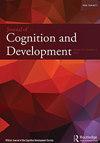儿童在游戏过程中物体插入的发展变化
IF 2.1
2区 心理学
Q3 PSYCHOLOGY, DEVELOPMENTAL
引用次数: 1
摘要
儿童早期的空间游戏与各种空间和认知技能有关。然而,这些关联往往源于在不同年龄段使用不同任务的研究,这就留下了儿童在空间游戏中的自然行为如何从婴儿期发展到学龄前早期的问题。我们使用开放式空间游戏任务来确定12至48个月(N=6636名女孩)的典型发展儿童行为。具体来说,我们观察了幼儿插入商用形状分类器的情况,该分类器包括六个具有相应孔径的几何实体。完成这项任务的方法随着年龄的增长而变化。年龄较小的孩子主要将固体插入顶部的大开口中,这一策略不需要空间对齐即可成功。在24个月至30个月之间,儿童开始将固体插入相应的侧开口,这是一种在空间和运动上更困难的策略,需要将固体对准其适当的开口。这种模式表明,在24个月大的时候,孩子们开始采用更复杂的策略来解决运动问题。与年龄较小的参与者相比,年龄较大的儿童成功插入的比例也更高,并且儿童在年龄较小时成功插入了旋转对称形状(如圆形),而不是旋转不对称形状(如三角形)。这项研究代表了重要的第一步,为儿童在广泛的发展时期内的自然游戏行为提供了详细的基线,可用于告知空间和认知系统如何对空间游戏做出贡献。本文章由计算机程序翻译,如有差异,请以英文原文为准。
Developmental Changes in Children’s Object Insertions during Play
ABSTRACT Spatial play in early childhood is associated with a variety of spatial and cognitive skills. However, these associations are often derived from studies in which different tasks are used across different age ranges, leaving open the question of how children’s natural behaviors during spatial play develop from infancy into the early preschool years. We used an open-ended spatial play task to establish typically developing children’s behaviors from 12 to 48 months (N = 66, 36 girls). Specifically, we observed young children’s insertions into a commercially available shape sorter that included six geometric solids with corresponding apertures. Approaches to this task changed with age. Younger children primarily inserted solids into the large top opening, a strategy that did not require spatial alignment for success. Between 24 and 30 months, children shifted to inserting solids into their corresponding side openings, a more spatially and motorically difficult strategy that required aligning solids to their appropriate apertures. This pattern suggests that at 24 months, children begin to adopt more sophisticated strategies for this motor problem-solving task. Older children also completed a higher proportion of successful insertions compared to younger participants, and children successfully inserted rotationally symmetrical shapes (e.g., circle) at younger ages than rotationally asymmetrical shapes (e.g., triangle). This study represents an important first step in providing a detailed baseline of children’s natural play behaviors over a wide developmental period that can be used to inform how spatial and cognitive systems contribute to spatial play.
求助全文
通过发布文献求助,成功后即可免费获取论文全文。
去求助
来源期刊

Journal of Cognition and Development
Multiple-
CiteScore
4.00
自引率
0.00%
发文量
29
期刊介绍:
The Journal of Cognition and Development is the official journal of the Cognitive Development Society (CDS). Some CDS members are concerned with basic research or theory; others focus on policy issues and practical applications. The range of interests includes cognitive development during all stages of life, and we seek to understand ontogenetic processes in both humans and nonhumans. Finally, their interests encompass typical as well as atypical development, and we attempt to characterize both biological and cultural influences on cognitive change and continuity.
 求助内容:
求助内容: 应助结果提醒方式:
应助结果提醒方式:


